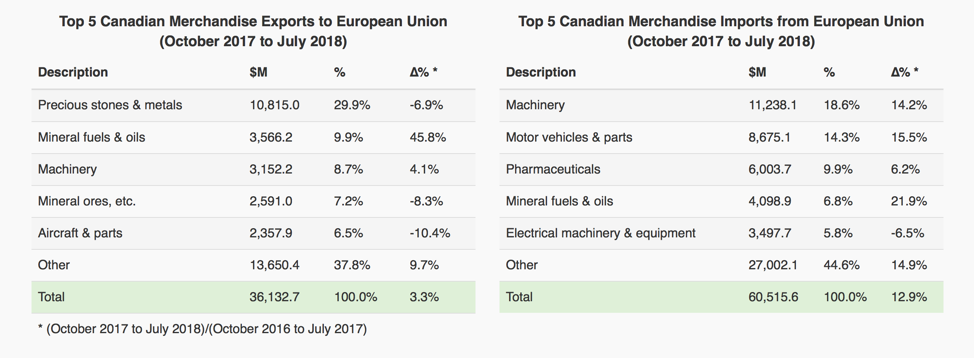Environmental Cooperation under CETA: Bold New Linkages, Bolder Risks
Sabaa A. Khan and Kati Kulovesi
Dr Sabaa A. Khan is Senior Researcher at CCEEL / UEF Law School. Her areas of expertise include regional trade agreements and she serves on the Joint Public Advisory Committee of the Commission for Environmental Cooperation, under an appointment by Canada’s Minister of Environment and Climate Change.
Dr Kati Kulovesi is Co-Director of CCEEL and Professor of International Law at the UEF Law School. She specializes in climate change law and holds a PhD in international economic law from the London School of Economics and Political Science.
The EU and Canada highlight climate change and the Paris Agreement in context of the CETA
In the same week as Canada, Mexico and the United States signed a new regional trade agreement that makes absolutely no mention of climate change, Canada and the EU made new efforts to formalize the climate change and trade linkage within the Canada-EU Comprehensive Economic and Trade Agreement (CETA). Representatives of the EU and Canada convened in Montréal for the inaugural meeting of the CETA Joint Committee, mandated to oversee and facilitate the implementation of all aspects of trade and investment under the CETA.
The meeting’s outcomes included a recommendation on ‘trade, climate action and the Paris Agreement’, reiterating the Parties’ shared commitment to the international climate change regime and Article 24.12(1)(e) of the CETA that specifically addresses climate change. The recommendation further signals the Parties’ intention to “step up the role of the Paris Agreement in their bilateral cooperation”.
This can be seen as a promising signal that the international climate change regime will play a salient role in shaping mega-regional trade flows. It is worth noting, however, that the increased trade in merchandise that has taken place under the first year of the CETA’s provisional application appears to be in sectors that are energy-intensive, and closely linked to the high-emissions extractive industries.
Source: Government of Canada
Moreover, the Joint Committee’s reaffirmation of the Paris Agreement at this point in time is an environmental moment worth modest celebration in light of ongoing concerns regarding the potentially massive environmental implications of the CETA investment protection provisions and the legally-ambiguous investment tribunal established under Art. 8.27.
Will the CETA’s Investment Chapter Have a Negative Impact on Environmental Protection in the Finnish Mining Sector?
While Canada and the EU continually underscore the immense mutual benefit that the CETA brings to businesses and communities and its environmentally progressive nature, it is difficult to ignore that the greatest environmental impact of the CETA is likely to be determined by its Investment Chapter, not the Trade & Environment Chapter that is explicitly dedicated to environmental issues.
The basic idea underlying the CETA’s Investment Chapter is to ensure that investors are treated equally and fairly, and that there is no discrimination between domestic and foreign investors. One of the mechanisms it includes for foreign investment protection is the possibility for investors to take legal action against governments through a new Investment Court System. A critical apprehension in this respect is that the prospect of costly legal challenges and damage to a country’s reputation in hosting investment might discourage governments from taking legitimate and necessary regulatory and administrative actions to protect environmental and public interests.
Even though the Investment Chapter reaffirms Parties’ regulatory right with regard to achieving legitimate policy objectives, including the protection of public health and the environment (Article 8.9), the provision on what constitutes a breach of fair and equitable treatment of investors (Article 8.10.4) leaves open the possibility for an investor to challenge governmental measures based on “legitimate expectations.” In light of these provisions, there are valid concerns that the CETA’s profitable implications for Canadian and EU investors come at the expense of the Parties’ willingness to regulate in the public interest and according to the principle of sustainable development.
In the context of the mining industry in particular – a key Canadian sector expected to benefit from the trade agreement – it is difficult to set aside the potential environmental and public health risks for EU Member states that are linked to the CETA’s investment protection rules and dispute settlement architecture. With over 50% of publicly-listed global exploration and mining companies headquartered in Canada, the CETA has not only opened up EU market access to a lucrative and globally powerful group of corporations, it has empowered them through the investment protection chapter to challenge public policy measures that interfere with their natural resource development projects.
In Finland, the mining sector has been one of the key concerns in the context of the CETA. Past negative experiences, including from the Talvivaara mine, have increased the public’s awareness of the sector’s potential environmental impact. When approving the CETA, the Parliament requested the government to evaluate the need to reform the Finnish mining legislation in consideration of the CETA. In response, the government commissioned an expert report, which saw no need for reform. The report’s key message is that the Finnish legal system already contains adequate protection to ensure investors’ fair and equitable treatment.
This finding and the report have, however, generated controversy, not least because the report was commissioned from a law firm known for representing the interests of the mining sector and multinational mining companies. One of the questions is whether the legal analysis in the report is objective enough to constitute a response to the Parliament’s request.
Looking at the report commissioned by the Finnish government, it contains comprehensive and well-informed analysis of the Finnish national legislation. However, the international law dimension would have merited more attention. This would have included analyzing relevant case law to understand what kind of government actions have been challenged through investor-state dispute settlement. Such analysis should have studied at least case law involving the mining sector and Canadian mining companies.
Looking at investor-state dispute settlement, Canadian mining companies already have an extensive track record in seeking financial compensation from governments through arbitral disputes. The request for arbitration filed at the International Center for Settlement of Investment Disputes (ICSID) by Toronto-listed Gabriel Resources against Romania, seeking $4.4 billion for alleged losses in its halted gold-mining project, and the dispute between Vancouver-based Eldorado Gold and Greece (ruled in favor of Eldorado Gold) over the environmental impacts of mine development in the northern region of Halkidiki, are reflective of the kind of mining disputes that could proliferate under the CETA.
In the Gabriel Resources vs. Romania case, the mining company is basing its claim on “unjustified delays in the administrative permitting process, imposing shifting and non-transparent legal requirements, politicizing applicable legal and administrative processes, and ultimately abdicating the responsibility to make decisions on the permitting of the Project in contravention of the applicable legal framework.” In Eldorado Gold vs Greece the claimant’s argument also concerned, inter alia, delays over issuing environmental permits.
A quick glance at the relevant case law thus shows that legal arguments made in the actual proceedings tend to be more complex than those studied in the expert report commissioned by the Finnish government. It would therefore have been useful to also study the actual case law and consider its relevance in the Finnish context. Whether this would have affected the overall conclusion remains unknown without comprehensive analysis.
Overall, the concern remains over the CETA’s Investment Chapter risking to immobilize EU Member states’ from regulating in the interest of public and environmental health protection. Of course, Canada could face similar challenges brought on by EU investment in Canada-based mining operations. Since the Investment Chapter has not been implemented under the provisional application, and the CETA itself has yet to be fully ratified, there is still space for EU Member states to bring in mining legislation reforms to counteract the possible financial, environmental and public health risks associated with the expansion of Canadian mining interests in the EU.


